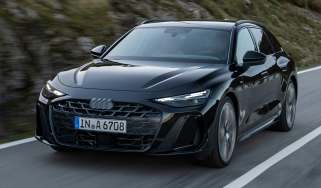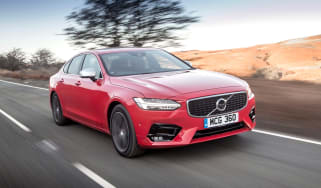Volvo V90 Cross Country estate
“The Volvo V90 Cross Country is a real alternative if you don’t want an SUV”
Pros
- Non-SUV personality
- All-weather agility
- Gorgeous interior
Cons
- Pricy to buy
- Uninspiring handling
- More expensive to run than V90
Despite offering one of our favourite SUVs in the shape of the Volvo XC90, the Swedish company knows that not everybody needs – or wants – a car like that. Although SUVs have never been more popular, they’re actually far from ideal in many circumstances; their bulk and height can be a liability in urban environments, for example.
 Best estate cars on sale in 2025
Best estate cars on sale in 2025
The Volvo V90 Cross Country offers all the major virtues of an SUV that owners are likely to use regularly – space, versatility and a firm grip on the road in adverse weather conditions – and wraps them up in an elegant shape that’s more akin to that of a normal car, give or take a few visual clues as to its capabilities.
The Cross Country builds on years of Volvo expertise in designing estate cars that can cope with the worst Scandinavian winter. Although it competes with the Audi A6 Allroad and Mercedes E-Class All-Terrain, many will prefer its more low-key design. It’s a far less showy machine than its rivals and all the more handsome for it – adding to the already crisp-looking V90 with butch yet subtle protective cladding and wheelarch extensions.
A 65mm increase in ground clearance combines with a standard four-wheel-drive system to deal with soft, uneven ground, as well as better traction on greasy or icy surfaces. An off-road setting is added to the drive mode selector, managing the engine’s power and automatic gearbox for those off-tarmac excursions.
More reviews
In-depth reviews
Road tests
The Cross Country is available with a petrol engine: a 2.0-litre B5 provided as an alternative to the B5 diesel, that offers the appealing prospect of 247bhp boosted by a turbocharger that gives maximum pulling power from just 1,800rpm. The B5 diesel is arguably the more sensible choice, returning up to 44.8mpg and with a still respectable 232bhp.
No V90 is what you might call responsive, though, and the Cross Country's modifications don’t add to the model's appeal as a dynamic driver’s car on twisty roads. They do make it a more useful rough-road companion, though, and inspire great confidence when conditions get tough. Meanwhile, passengers not involved with driving can relax in one of the best interiors on the market, with lavish materials throughout and a long list of up-to-date standard equipment.
Overall, the V90 Cross Country makes a fascinating all-weather alternative if you don’t want to jump on the SUV bandwagon, but the B5 diesel is a far more balanced package than the thirsty B5 petrol.
MPG, running costs & CO2
It would be churlish to ask Volvo to add four-wheel drive, greater ride height and a weight increase to the standard V90 without increasing its fuel consumption. Yet the Cross Country modifications haven’t had the big impact you might expect.
The 232bhp B5 diesel model can return up to 44.8mpg, but its CO2 emissions of 164-179g/km place it towards the top of the Benefit-in-Kind (BiK) company-car tax table. We also found you're only likely to hit its official economy figure on longer runs; take on frequent stop and start driving in town or hilly country lanes and a figure below 40mpg is more likely. Every Cross Country costs over £40,000, so there's a luxury car VED (road tax) surcharge in years two to six, reverting to the standard rate after that.
A 190bhp D4 version used to be available, too, producing slightly less CO2. It was only a little more economical, at 54.3mpg.
Go for the powerful B5 petrol and you'll feel it in your pocket. Fuel economy is quoted as 36.2mpg overall, but it's unlikely you'll see much more than 30mpg in regular driving. CO2 emissions of 177-193g/km mean a top BiK bracket for company-car tax, too.
Other running costs are liable to be similar to other V90 models – insurance and servicing will be around the same, but the Cross Country’s sturdy all-weather tyres may be more costly to replace when worn.
Engines, drive & performance
The regular Volvo V90 isn’t quite as focused on delivering driver fulfilment as the BMW 5 Series Touring or Mercedes E-Class Estate and this is actually a rather refreshing decision on Volvo’s part. Like the regular car, the Cross Country indulges rather than entertains, allowing motorway miles to slip by almost unnoticed.
This isn’t to say the Cross Country doesn’t handle well – it’s neat and tidy on twisty roads when pushed hard, although its raised height does lead to it leaning a little into bends. The steering is light and not especially rich with information – even when dynamic mode is selected – but guiding the car through corners is effortless.
You’re never short of grip, either – four-wheel drive sees to this, usually sending power to the front wheels but summoning the rears when conditions demand. When we tested the car on winter tyres in Swedish snow, its all-weather capabilities really came to the fore.
The B5 diesel engine is punchy and responsive (0-62mph takes 7.5 seconds) and remarkably quiet. Power is also decent in the B5 petrol, with 245bhp being enough to take it from 0-62mph in 7.4 seconds and the acceleration feels all the more impressive with the reassuring grip of four-wheel drive.
However, it falls short of appealing to enthusiastic drivers because of the rather frustrating lag between depressing the accelerator and all that power being unleashed, with the eight-speed automatic gearbox hesitant to shift down when you want it to. On the other hand, at tickover and when cruising, the petrol engine is very quiet and enjoyably smooth.
Interior & comfort
One of the regular V90’s greatest fortes is how well it looks after its passengers and this hasn’t been compromised in the Cross Country. Even with the noisy winter tyres of our test car, the interior remained peaceful – remarkable as the huge void at the back of estate cars can often echo and amplify noise.
There’s not a lot of wind noise, either, despite the Cross Country’s increased height, and the increased suspension travel brings a softer ride, too, with only the occasional pothole piercing the tranquility. Our test car was fitted with the optional air-suspension system, which makes things even smoother, but the regular V90 is a comfortable cruiser anyway, so we expect the standard suspension to be perfectly acceptable.
The Cross Country’s lofty profile also contributes towards a good view out for driver and passengers, and there’s a definite sense that you’re sitting in something other than a standard estate car – a sense made real when you pay attention to the interior materials, none of which are anything other than first-class. No scratchy, plasticky surfaces here.
The V90’s design is modern and fresh-looking. The showcase feature is a central portrait-mounted touchscreen for Volvo’s latest infotainment system, which incorporates Apple CarPlay and Android Auto. It’s a good system and recognises pinch-to-zoom gestures like your smartphone does, but some of the sub-menus can be a bit overwhelming. Standard equipment also includes sat nav, LED lighting and dual-zone climate control.
Practicality & boot space
Adding to its credentials as a real alternative to a traditional SUV, the Volvo V90 Cross Country is a seriously practical machine. It matches the conventional V90 estate for load space – there are 551 litres for luggage, expanding to 1,517 litres if you fold the rear seats flat.
The size and practical nature of the boot means that most won’t need to drop the seats very often, and the Cross Country will comfortably accommodate a family of four, even if every member is six feet tall. There’s room for a fifth, too, in the centre rear seat, although there’s a hump in the floor that limits foot space, making this seat most comfortable for children.
The Mercedes E-Class All-Terrain has even more space in the passenger compartment and boot, but the comparison is just a numbers game – we feel the Volvo will be more than big enough for most.
Reliability & safety
The Volvo V90 is still a relatively recent car to the UK market and it’s not yet appeared in our annual Driver Power customer satisfaction survey. There’s no reason to believe the Cross Country variant should differ much from the V90 in this area.
Volvo as a brand finished in an impressive ninth place in our 2021 survey. Volvo owners tend to report good things about build quality and servicing costs – but they also reported high fuel consumption. When it comes to reliability, 20% of Volvo owners reported one or more faults in the first year – a figure that Volvo will no doubt want to improve on.
Safety isn’t in question at all, though. The V90 was awarded five stars when independent crash safety experts Euro NCAP evaluated it, scoring an excellent 95% for adult occupant protection and 80% for the way it looks after children. It has always taken safety very seriously and is at the forefront of developing autonomous driver aids to reduce the likelihood of hazardous incidents.
Volvo hopes that by 2020, nobody will be killed or seriously injured in or by one of its cars. It has always taken safety very seriously and is at the forefront of developing autonomous driver aids to reduce the likelihood of hazardous incidents.
The Cross Country incorporates City Safety, with automatic emergency braking if a hazard is detected, as well as a semi-autonomous Pilot Assist system. This combines the car’s active cruise control with readings from various cameras, lasers and sensors to control speed, acceleration and braking in certain traffic conditions up to a certain speed. You can even set your Cross Country up to communicate with other Volvos for advance warning of hazards ahead.






















